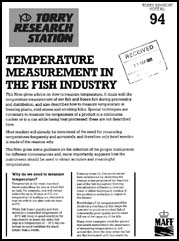Contents Index

Accompanying Notes
Table of Contents
TORRY RESEARCH STATION
TORRY ADVISORY NOTE No. 94
This Note gives advice on how to measure temperature. It deals with the temperature measurement of wet fish and frozen fish during processing and distribution, and also describes how to measure temperature in freezing plants, cold stores and smoking kilns. Special techniques are necessary to measure the temperature of a product in a continuous cooker or in a can while being heat processed: these are not described here.
Most readers will already be convinced of the need for measuring temperatures frequently and accurately, and therefore only brief mention is made of the reasons why.
The Note gives some guidance on the selection of the proper instruments for different circumstances and, more importantly, suggests how the instruments should be used to obtain accurate and meaningful temperatures.
Crown copyright material is reproduced with the permission of the Controller of Her Majesty's Stationery Office.
This electronic document has been scanned using optical character recognition (OCR) software and careful manual recorrection. Even if the quality of digitalisation is high, the FAO declines all responsibility for any discrepancies that may exist between the present document and its original printed version.
Briefly describes why it is important to measure temperature in the fish industry. Explains and gives practical advice on how to measure temperature accurately in different situations, products or materials, such as wet and frozen fish during processing and distribution, in products in freezers during freezing, in cold stores, in retail cabinets, in smoking kilns, and the air in air blast freezers. Measurement of freezing times of products is also dealt with. Gives guidance on the selection and calibration of thermometers with regard to accuracy, resolution, range, response and operational limits. An appendix describes types of thermometer in common use and suitability for different applications. This Note should be considered alongside the many others in the series where temperature measurement is relevant.
(FAO in partnership with Support unit for International Fisheries and Aquatic Research, SIFAR, 2001).
Why do we need
to measure temperature?
What do we use to measure
temperature?
Temperature measurement
of wet fish
Temperature
measurement of fish during freezing
Temperature measurement
of frozen fish
Practical
points in measuring fish temperature
Measurement of cold
store temperature
Temperature
measurement of air in blast freezers
Temperature measurement
in smoking kilns
Instrument selection
Calibration of thermometers
APPENDIX
Contents Index